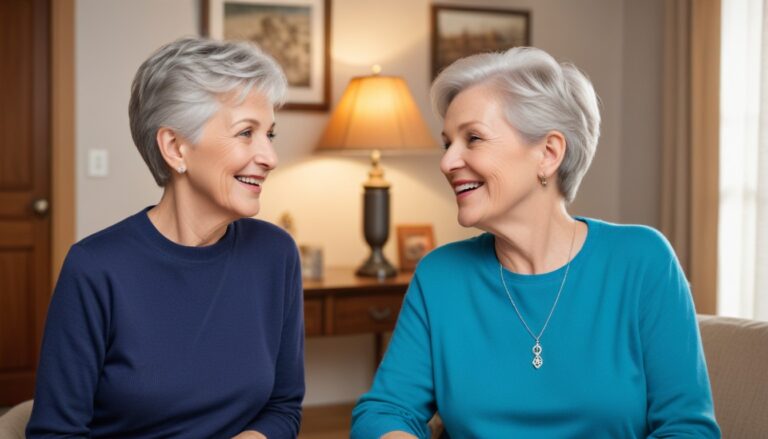This guide will help you answer The RQF Level 2 Diploma in Care Unit 1.3 Explain why it is important to observe and individual’s reactions when communicating with them.
Observing an individual’s reactions during communication is important in health and social care settings for several important reasons.
Each person is unique, and their reactions provide essential cues that can guide the communication process, ensuring it is effective and person-centred.
Understanding Non-Verbal Cues
A significant portion of communication is non-verbal. People often express their feelings and reactions through body language, facial expressions, eye contact, and gestures. By observing these non-verbal cues, care workers can gain insight into how the individual is feeling and how they are responding to the information being shared.
Assessing Comprehension
Individuals may not always verbally express that they do not understand something. By paying close attention to their reactions, such as confusion or uncertainty in their facial expressions, a care worker can determine whether further explanation or a different approach is needed to ensure the individual understands the communication.
Responding to Emotional Needs
Communication is not just about exchanging information; it is also about connecting with the individual on an emotional level. Observing an individual’s reactions allows the care worker to detect emotions such as discomfort, anxiety, happiness, or frustration. This awareness enables the worker to respond appropriately, for instance, by providing reassurance or comfort if the person appears distressed.
Promoting Engagement
Effective communication involves active participation from both parties. By observing the individual’s reactions, a care worker can gauge their level of engagement and interest. If the person appears disinterested or disengaged, the worker can modify their approach to re-engage the individual and facilitate meaningful interaction.
Ensuring Safety
In some cases, an individual’s reaction might indicate a potential risk to their safety or well-being. For example, if a care worker observes signs of physical discomfort or distress, they can take immediate action to address the issue and ensure the individual’s safety.
Building Trust and Rapport
Observing and responding to an individual’s reactions demonstrates that the care worker values their input and respects their feelings. This attentiveness fosters a more trusting relationship and encourages open and honest communication.
Different cultural backgrounds may influence how individuals express themselves. Being observant helps care workers to navigate and respect these cultural differences, ensuring that communication is respectful and appropriate to the individual’s cultural context.
Adapting Communication Methods
Some individuals may have specific communication needs, such as those with hearing impairments, speech difficulties, or cognitive impairments. Observing their reactions helps care workers to identify these needs and adapt their communication methods accordingly, for example, by using visual aids, simpler language, or alternative communication devices.
Example answers for Unit 1.3 Explain why it is important to observe and individual’s reactions when communicating with them
Here are some example answers a care worker might give when explaining why it is important to observe an individual’s reactions when communicating with them:
Example Answer 1:
“Observing an individual’s reactions when communicating is important because it helps me understand how they are feeling and whether they are comfortable with the information I am sharing. For instance, if I’m explaining a new medication routine and the person looks confused or anxious, I know I need to take a step back and provide further clarification or reassurance. This ensures that they fully understand and feel at ease with their care plan.”
Example Answer 2:
“I find it essential to watch for non-verbal cues, such as facial expressions or body language, while communicating. One time, I was talking to a resident about their upcoming medical appointment. Although they were verbally agreeing, their crossed arms and lack of eye contact suggested they were uneasy. By noticing this, I was able to ask them directly how they felt, and they expressed some concerns which I was then able to address, making them feel more comfortable and listened to.”
Example Answer 3:
“In my role, I’ve learnt that not everyone can verbally express their needs or feelings clearly, especially those with dementia or learning disabilities. By closely observing their reactions, I can pick up on subtle signs of distress or discomfort. For example, if someone starts fidgeting or avoids eye contact during our conversation, it might indicate they are feeling anxious or confused. This allows me to pause, reassure them, and adjust my communication technique to better meet their needs.”
Example Answer 4:
“Understanding and empathy are essential in our line of work. When I see someone smile or relax their posture while we’re talking, I know they are comfortable and engaged. On the other hand, if they look away or become tense, it signals that something might be wrong or not fully understood. Observing these reactions helps me build a stronger, trusting relationship with them because it shows I am attuned to their emotions and ready to support them in whatever way they need.”
Example Answer 5:
“Cultural sensitivity is also an important aspect of our job. Different cultures express themselves in various ways. By observing how individuals from diverse backgrounds react during our interactions, I can better appreciate and respect their cultural norms and preferences. For example, some cultures may avoid direct eye contact as a sign of respect, while others might expect it as a sign of attentiveness. Understanding these nuances helps me communicate more effectively and respectfully.”
Example Answer 6:
“When assisting individuals with specific communication needs, such as those with hearing impairments, reading their reactions is really important. Once, I was explaining something to a hard-of-hearing individual and noticed they were still puzzled after my explanation. By recognising this, I switched to using visual aids and written notes, which made our communication much clearer and ensured they understood the message. This adaptability is key to providing inclusive and effective care.”
By providing these detailed and specific examples, a care worker demonstrates a deep understanding of the importance of observing an individual’s reactions and how it directly impacts the quality of care and communication.
Summary
In summary, observing an individual’s reactions when communicating is really important for delivering high-quality, person-centred care. It ensures that communication is effective, empathetic, and responsive to the needs and preferences of the individual, thereby enhancing their overall well-being and the quality of care provided.
Subscribe to Newsletter
Get the latest news and updates from Care Learning and be first to know about our free courses when they launch.







